Observation on Clinical Effects of Tuina plus Hot Compress for Infantile Diarrhea Due to Spleen-kidney Yang Deficiency
Department of Acupuncturemoxibustion and Tuina, Nanjing Integrated Traditional Chinese and Western Medicine Hospital, Nanjing University of Chinese Medicine, Nanjing 210014, China
TUINA TECHNIQUE AND EXERCISE
Observation on Clinical Effects of Tuina plus Hot Compress for Infantile Diarrhea Due to Spleen-kidney Yang Deficiency
Ye Kang
Department of Acupuncturemoxibustion and Tuina, Nanjing Integrated Traditional Chinese and Western Medicine Hospital, Nanjing University of Chinese Medicine, Nanjing 210014, China
Author: Ye Kang, master of medicine.
E-mail: yk05803112@126.com
Objective: To observe the clinical effects of tuina plus hot compress for infantile diarrhea due to spleen-kidney yang deficiency.
Methods: One hundred cases were randomly divided into a treatment group and a control group, 50 cases in each group. The treatment group was treated with tuina plus hot compress. The control group was treated with oral administration of Live Combined Bifidobacterium, Lactobacillus and Enterococcus powder (Bifico). The clinical effects were observed after 5-day intervention.
Results: The total effective rate was 94.0% in the treatment group and was 66.0% in the control group. The difference in the total effective rate between the two groups was statistically significant (P<0.05). The clinical effect was better in the treatment group than that in the control group.
Conclusion: Tuina plus hot compress for infantile diarrhea due to spleen-kidney yang deficiency can produce a better clinical effect than oral administration of Bifico.
Tuina; Massage; Hot Compress; Point, Shenque (CV 8); Diarrhea, Infants;Spleen-kidney Yang Deficiency
Infantile diarrhea is a common clinical disorder, characterized by increased frequency of bowel movements, thin stools, even watery stools. The sick children of this problem are susceptible to dehydration, acidosis and electrolyte imbalance, and the lingering duration can also lead to malnutrition, retarded growth and development, and even death. In order to investigate the clinical efficacy of Chinese medicine and tuina for this disease, I treated infantile diarrhea due to spleen-kidney yang deficiency by tuina plus hot compress. Now, the report is given as follows.
1 Clinical Materials
1.1 Diagnostic criteria
By referring to the diagnostic criteria of infantile diarrhea due to spleen-kidney yang deficiency in theCriteria of Diagnosis and Therapeutic Effects of Diseases and Syndromes in Traditional Chinese Medicine[1]by the State Administration of Traditional Chinese Medicine, based upon the symptoms of increased frequency of bowel movements, in 3-5 times, or up to 10 times a day; scanty urine, elevated body temperature, vexation and thirst, low spirit, dry skin, and sunken fontanel in severe condition;loose stools with undigested food, weight loss, or facial puffiness, cold sensation in the four limbs, a pale tongue with white coating, thready and forceless pulses.
1.2 Inclusion criteria
In conformity with the above diagnostic criteria of infantile diarrhea due to spleen-kidney yang deficiency, able to accept tuina treatment, without skin lesion at the treatment site, with the age from 3 months to 3 years.
1.3 Exclusion criteria
Not in conformity with the above diagnostic criteria, complicated with other diseases, age below 3 months or over 3 years; severe infectious diarrhea (enteritis, dysentery or cholera) or diarrhea caused by organic diseases of clear pathogens.
1.4 Statistical methods
Statistical analysis was processed by SPSS 13.0 version statistical software. Measurement data were expressed as mean ± standard deviationby usingt-test. The counting data were processed by Chi-square test.P<0.05 indicates a statistical significance.
1.5 General data
Totally 100 cases were enrolled from the Pediatric and Tuina Clinic of our hospital and were randomly divided into a treatment group and a control group, 50 cases in each group. In the treatment group, the age ranged from 8 months to 3 years old. In the control group, the age ranged from 7 months to 3 years old. By the statistical management of the age and duration in the two groups, the differences were not statistically significant (allP>0.05), indicating that the two groups were comparable (Table 1).

Table 1. Comparison of general data between the two groups
2 Therapeutic Methods
2.1 Treatment group
2.1.1 Tuina
Bu-reinforcing Pijing: After the thumb of sick child was flexed, the doctor pushed the radial side of the thumb straightly toward the base of the palm with the side of the thumb for 500 times (Figure 1).
Bu-reinforcing Dachang: The doctor pushed the radial side of the index finger of the sick child from the fingertip toward palm straightly with the thumb, for 300 times continuously (Figure 2).
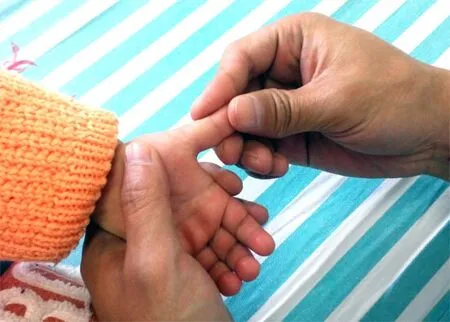
Figure 1. Bu-reinforcing Pijing
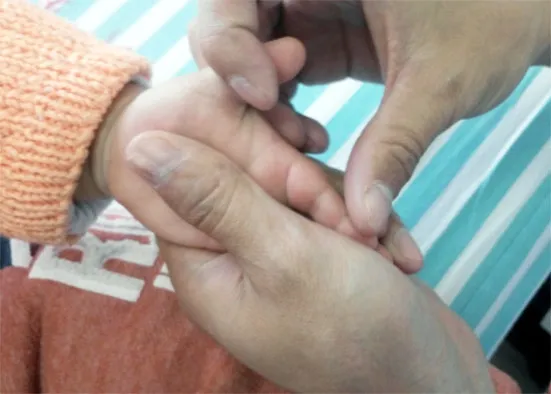
Figure 2. Bu-reinforcing Dachang
Tui-pushing Sanguan: The doctor pushed the wrist to the elbow with finger pulps of the thumb or the index and middle fingers for 300 times (Figure 3).

Figure 3. Tui-pushing Sanguan
Mo-rubbing the abdomen: After the sick child took a supine position, and a circle was determined by the connecting line between Shangwan (GV 13) and Guanyuan (GV 4) as diameter, the doctor closed the four fingers and Mo-rubbed the abdomen along this circle clockwise for 500 times (Figure 4).
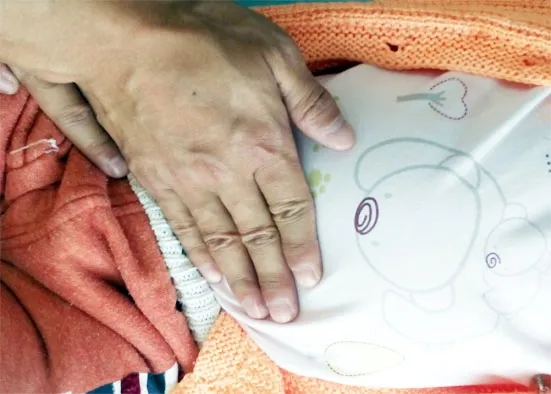
Figure 4. Mo-rubbing the abdomen
Rou-kneading Guiwei: After the sick child took a prone position, the doctor adhered the tailbone of the sick child with the thumb pulp, with the rest four fingers on the sacral region, and then Rou-kneaded with the thumb for 300 times (Figure 5).
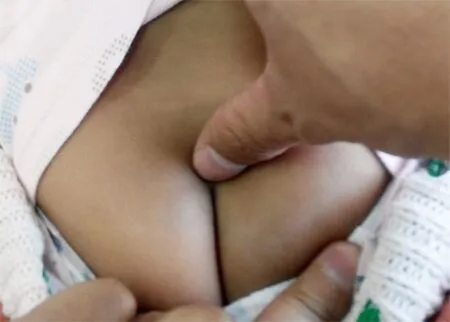
Figure 5. Rou-kneading Guiwei
Tui-pushing up Qijiegu: The doctor Tui-pushed Qijiegu upward from the bottom with the radial side of the thumb for 300 times (Figure 6).
Nie-pinching the spine: After the sick child took a prone position, the doctor held the skin of the sick child’s back with the two thumbs, with the rest four fingers before the thumbs, to pinch up the skin with the two hands simultaneously, along the bilateral Bladder Meridian, from Xialiao (BL 34) to Dazhu (BL 11) upward, for 6-9 times repeatedly (Figure 7).
Tuina treatment was given once every day. Each treatment lasted for about 20 min. Five sessions made one course.
2.1.2 Hot compress
After 500 g coarse salt was fried to brown color and put into a cotton bag, the cotton bag was put on the lower abdomen of the sick child with Shenque (GV 8) as the center, for 30 min each time. The treatment was given once every day and five sessions made one course.
2.2 Control group
The sick children in the control group were treated by oral administration of Live Combined Bifidobacterium, Lactobacillus and Enterococcus tablet (Bifico), one tablet each time, once respectively in the morning and evening after meals. Five days made one course.
The clinical effects were assessed after one course in both groups.
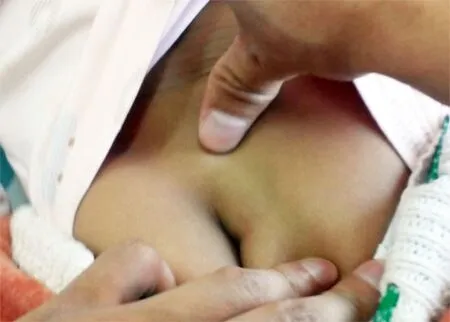
Figure 6. Tui-pushing up Qijiegu
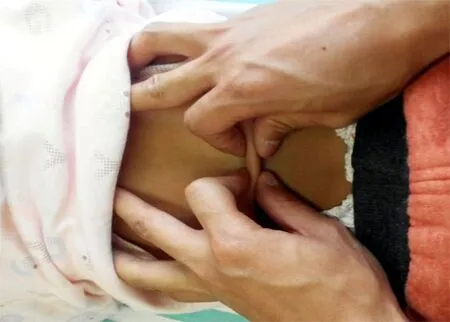
Figure 7. Nie-pinching the spine
3 Observation on Therapeutic Effects
3.1 Criteria of therapeutic effects
The criteria of therapeutic effects were stipulated by referring to theChinese Diagnostic and Therapeutic Protocols for Diarrhearevised in 1993 by Ministry of Health of the People's Republic of China[2].
Remarkable effect: Stool shape and bowel movements became normal, and general symptoms disappeared in 5-day treatments.
Effect: Stool shape and bowel movements were improved obviously, and general symptoms were obviously relieved in 5-day treatments.
Failure: Stool shape, bowel movements and general symptoms were not relieved or aggravated in 5-day treatments.
3.2 Therapeutic results
After the treatment for one course by the above method, the total effective rate was 94.0% in the treatment group and 66.0% in the control group. The difference of the total effective rate between the two groups was statistically significant (P<0.05), indicating that tuina plus hot compress was better than oral administration of Bifico for infantile diarrhea due to spleen-kidney yang deficiency.

Table 2. Comparison of therapeutic effects between the two groups (case)
4 Discussion
The infants belong to the body constitution of young yin and yang, and are delicate in Zang-fu organs and weak in the spleen and stomach. Either affection of the external pathogens and internal injury of milk food, or deficient cold in the spleen and kidney will lead to dysfunction in the transportation and transformation of the spleen and stomach, hence diarrhea. Bifico can supplement the normal physiological bacteria of the human body, regulate the balance of the intestinal flora, inhibit and clear away the pathogenic bacteria from the intestines, reduce the production of the intestinal toxin, promote the absorption of the nutrients, synthesize the vitamins in the body and excite the immune ability, with a better therapeutic effect for acute and chronic diarrhea induced by imbalance of the intestinal flora[3-5]. But, as a medication for the treatment of infantile diarrhea, Bifico can only treat the symptoms and cannot change the constitution of the infants.
Pediatric tuina plus hot compress can stimulate the corresponding acupoints, regulate the spleen and stomach, balance yin and yang, and strengthen Zang-fu organs functions, so as to treat the disease and enhance the immune ability, and also promote the growth and development[6-10]. Its main effect is supposed to treat the causative factor, which is beyond the oral medication.
By the clinical observation, I believe that tuina plus hot compress for infantile diarrhea due to spleen-kidney yang deficiency is safe, convenient, simple, and significant in the effect, free of adverse reactions, and painless, and easy to be accepted by the children, and is worthy of clinical popularization. In addition, the dietetic nursing is very important for infants with diarrhea. During treatment, it is necessary to have light and plain food, have more meals but in small portion and pay attention to food hygiene.
Conflict of Interest
There was no conflict of interest in this article.
Acknowledgments
This work was supported by Nanjing Integrated Traditional Chinese and Western Medicine Hospital, Nanjing University of Chinese Medicine.
Statement of Informed Consent
Informed consent was obtained from all individual participants’ parents included in this study.
[1] State Administration of Traditional Chinese Medicine. Criteria of Diagnosis and Therapeutic Effects of Diseases and Syndromes in Traditional Chinese Medicine. Nanjing: Nanjing University Press, 1994: 79.
[2] Fang SH, Duan SC, Dong ZQ, Yu AH, Liu XY, Zhang JX, Peng WW, Xiao DL, Zheng QS, xie LC, Liu ZE, Du MN, Bao XL, Wang WJ, Bi ZQ, Song YT. Chinese diagnostic and therapeutic protocols for diarrhea. Zhongguo Shiyong Erke Zazhi, 1998, 13(6): 381-384.
[3] An GQ, Li N, Zhai GH, Liu HR, Sun JF, Liang HF, Xu RY. Evaluation of the therapeutic effect of acupuncture and moxibustion on irritable bowel syndrome. Shanghai Zhenjiu Zazhi, 2010, 29(6): 354-356.
[4] Luo JS, Jiang XF. Observation on clinical effect of Bifico for infantile diarrhea. Zhongguo Shequ Yishi: Yixue Zhuanye. 2013, 15(9): 149.
[5] Xu S, Wang SC, Li JQ, Chen XZ, Xu L, Bai LJ. Research on children’s diarrhea with food damage syndrome based on survival analysis. CJTCMP, 2013, 28(1): 275-277.
[6] Chen LC. Observations on the efficacy of rapid needling plus massage in treating infantile diarrhea. Shanghai Zhenjiu Zazhi, 2011, 30(7): 447-449.
[7] Shen YJ, Chen ZW, Jin YC. Curative effect observation on tuina therapy for spleen-deficiency infantile diarrhea. J Acupunct Tuina Sci, 2013, 11(1): 26-30.
[8] Pan D, Lang BX, Cai SH, Lin Q. Observations on the efficacy of pricking therapy plus massotherapy for infantile diarrhea. Shanghai Zhenjiu Zazhi, 2012, 31(11): 831-832.
[9] Yao Y, Zhao Y. Diseases spectrum study on pediatric tuina in recent 10 years. J Acupunct Tuina Sci, 2012, 10(3): 181-184.
[10] Xin Q, Du DQ, Ma YX, Wang ZL, Gao SZ, Wang XY. Herbpartitioned moxibustion on Shenque (CV 8) for treating irritable bowel syndrome of spleen deficiency. Shanghai Zhenjiu Zazhi, 2011, 30(8): 517-519.
Translator: Huang Guo-qi
R244.1
: A
Date:January 25, 2014
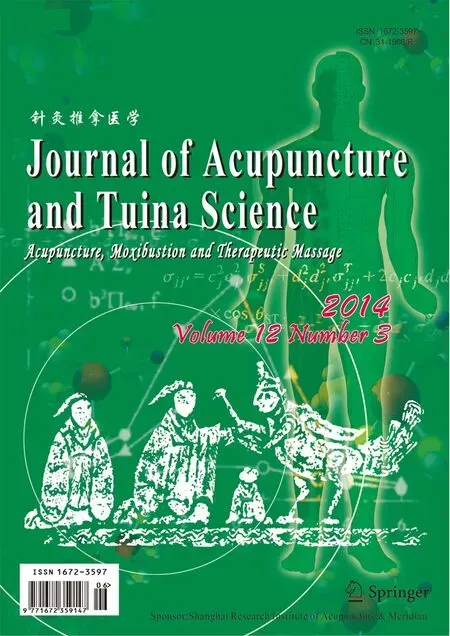 Journal of Acupuncture and Tuina Science2014年3期
Journal of Acupuncture and Tuina Science2014年3期
- Journal of Acupuncture and Tuina Science的其它文章
- Therapeutic Efficacy Observation on Combined Taijiquan and Auricular Point Sticking for Perimenopausal Insomnia
- Clinical Study on Fu’s Subcutaneous Needling with Laser for Postherpetic Neuralgia
- Clinical Study on Point Application Using Chinese Herbal Medicine for Pediatric Chronic Cough
- Therapeutic Effect Observation on Combining Electroacupuncture and Tuina for Migraine
- Blood Perfusion Effect of Acupuncture on Acute Facial Paralysis Observed by Laser Speckle Technique
- Therapeutic Efficacy of Tuina in Treating 48 Cases with Knee Osteoarthritis
